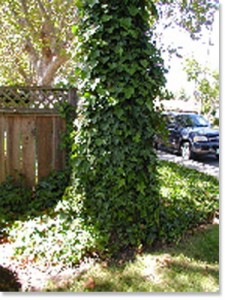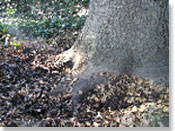- About Us
- Our Work
- Tree Info
- Get Involved
- Blog
- Volunteer
- Support Us

Mature trees provide shade and many benefits to the urban environment. While they require different treatment than young trees, they still need regular watering, pruning, disease prevention, and protection.
Mature trees grow more slowly than young trees and are very sensitive to their surrounding environment. If older trees are damaged or left with large pruning wounds, they regrow wood slowly and are more susceptible to disease.
If watered improperly or growing in poor soil conditions, the tree’s health will start to decline. The tree may be stressed for a long period of time before it shows significant symptoms such as leaf or branch drop. Watch trees carefully for foliage changes to catch problems early, and begin care and treatment.
3 steps to help your mature tree thrive
1. Water the right amount
The number one thing you can do for mature tree health is to make sure that the amount of water supplied is appropriate for your tree. For most mature trees, regular monthly deep watering is recommended in the absence of soaking rain. Consult Canopy’s Trees and Water Section to learn how much and when to water your tree.
2. Prune wisely
Mature trees need to be pruned regularly to remove dead or diseased wood and to remove excessive weight from the ends of branches. The process called “end-weight reduction” will reduce the likelihood of branch breakage and hazards. Make sure a trained professional, ideally a Certified Arborist, prunes your tree. Inadequate pruning compromises the health of trees. Whatever you do, avoid “topping” your tree—this harmful practice ruins the tree’s natural structure, starves the tree by removing a high percentage of food-producing leaves, creates openings for disease, and initiates the tree’s eventual demise.
3. Watch for pests or diseases
Learn about tree pests and diseases that may affect your tree. If you suspect disease, consult a Certified Arborist. The arborist can also inspect the tree for weak branch attachments and periodically check your tree for safety. Watch trees carefully for foliage changes to catch problems early and begin care and treatment.
4 ways to protect your mature native oak
Native oaks require special attention because their roots share soil space with the Oak Root Fungus which specializes in living off of oak and other woody roots. Under natural California conditions, this fungus (Armillaria) is dormant during the hot, dry summer, and comes to life only with the winter rains.
Our native oaks—valley oak, coast live oak, and blue oak—do not require and do not tolerate irrigation in the dry months. If irrigation is applied near their trunk during the dry season, the Armillaria fungus will grow due to the combination of warmth and moisture. As the tree matures, continued watering around the trunk maintains the fungus infestation, which in turn will cause the tree to die, or tip over from too few roots to anchor its top weight.
1. Remove competing plants, including ivy and lawn
These plants can hide defects such as areas of decay and can trap moisture around the root crown, creating the perfect environment for fungus. Garbage collects under ivy and it creates a breeding ground for rats. Ideally all competing plants within the drip line will be removed. Laying mulch around the trunk (but leaving the root crown exposed) can help keep ivy and other plants from returning.

Don’t let your tree look like this! Once established, ivy can be difficult to remove.
How to remove ivy:
The method Canopy recommends is to remove as much of the ivy as you can by hand, including the roots. Ivy that is climbing up a tree should first be cleared away from the base of the trunk. Then, the ivy should be cut back 2-3 feet around the base of the tree. Pulling down the ivy higher up can damage the tree’s bark. Once detached from the roots, the ivy will die and can then be removed.
You will most likely not kill all of the ivy in this way and some of it will come back. Often you will have an 80% success rate the first time and 20% will return. Keep at it, in the end you will triumph.
If you choose to use a chemical weed killer to speed up the ivy removal process, locate any large main ivy roots. Cut the ivy root cleanly so that there is a fresh wound above the soil. Immediately paint a strong concentrate of Glyphosate, also sold as Roundup, or Kleenup. The Glyphosate will move through the ivy’s system and kill some of the plant without hurting the tree or surrounding plants.

A properly exposed root crown should look like the one in this photograph.
2. Remove built-up soil from around the root crown
Root crown fungus growth slows down when the fungus is exposed to air. By ensuring the root crown is dry and exposed to air, you will prolong the life of your tree. Removing dirt until you can see the root crown is called “root crown excavation.” It may expose the fungus and will remove moisture from the area.
3. Water properly
The area within 10 feet (or more) of the trunk of a native oak should remain undisturbed and clear of any vegetation and irrigation. Ideally no irrigation should be applied and no lawn installed in the area extending from the base of the trunk out to the tree’s drip line. It’s best to remove existing lawn inside the drip line; this will reduce competition from other plants and help eliminate excess moisture. Do not water or allow water to collect around the root flare. Do not allow sprinklers to spray on the trunk.
4. Have your tree evaluated for root crown infection
Contact an ISA-certified arborist for an inspection. An arborist should also be consulted if you see signs of decay in the wood, or clusters of mushrooms growing from or next to the trunk.